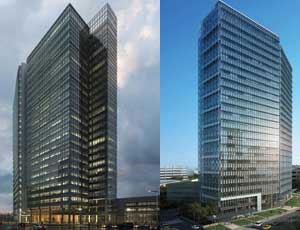Vista’s green credentials would make it the first platinum office tower on the Northeast Corridor Hub. In addition to the building’s solar orientation, designed to reduce heat gain and maximize natural lighting, Vista’s roof will have solar panels and stormwater collection, which will be diverted to a bioswale and rain garden. Construction materials will be locally sourced when possible, with a high percentage of recycled content. The HVAC system has been designed with cost-effective, high-efficiency systems.

Low-e glazing on the curtain-wall facades, combined with sunscreens, will further reduce heating and cooling expenses and serve as the defining elements of the tower.
“We evaluated all types of exterior wall systems,” says Attilio Rivetti, director of procurement and estimating for New York’s Turner Construction, which is handling the pre-construction services on the project. “The exterior wall on this type of project is significant. It’s going to give the building its identity.”
Brenna says the team is also considering growing plants on the facades as a shading device.
Rivetti says energy efficiency was achieved “just by sheer orientation of the building—and that doesn’t cost anyone anything.”
Coscia adds: “When you do a square building, you have the same exposure on all sides, and we used that as a benchmark. We [then] oriented it so that east and west are the most exposed, and energy usage went up 5 to 6% and we got some intense glass glare.” He says RMJM Hillier then played with several configurations and found that “by simply rotating the building, our energy use would drop 4 to 5% below the benchmark, and the quality of light would be better. And you get a better work environment.”
Key Players
Developer: Capital Real Estate Group, Trenton, NJ
Architect: RMJM Hillier, New York
Construction Consultant: Turner Construction Co., New York
Sustainability Engineer: Buro Happold, Bath, UK

Post a comment to this article
Report Abusive Comment